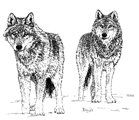Wildlife Damage Management, Internet Center for
Date of this Version
January 2007
Abstract
Second only to humans in adapting to climate extremes, gray wolves once ranged from coast to coast and from Alaska to Mexico in North America. They were absent from the East and the Southeast, which were occupied by red wolves (Canis rufus), and from the large deserts in the southwestern States. By the early 20th century, government-sponsored predator control programs and declines in prey brought gray wolves to near extinction in the lower 48 States. Wolf groups, or packs, typically include a breeding pair (the alpha pair), their offspring, and other non-breeding adults. Wolves are capable of mating by age two or three and sometimes form a lifelong bond. Wolves can live 13 years and reproduce past 10 years of age. On the average five pups are born in early spring and are cared for by the entire pack. For the first six weeks, pups are reared in dens. Dens are often used year after year, but wolves may also dig new dens or use some other type of shelter, such as a cave. Pups depend on their mother’s milk for the first month, then are gradually weaned and fed regurgitated meat brought by pack members. By seven to eight months of age, when they are almost fully grown, the pups begin traveling with the adults. After a year or two, wolves may leave and try to find a mate and form a pack. Lone, dispersing wolves have traveled as far as 600 miles in search of a new home.


Comments
Published by the U.S. Fish & Wildlife Service. 1-800-344-WILD. http://www.fws.gov.